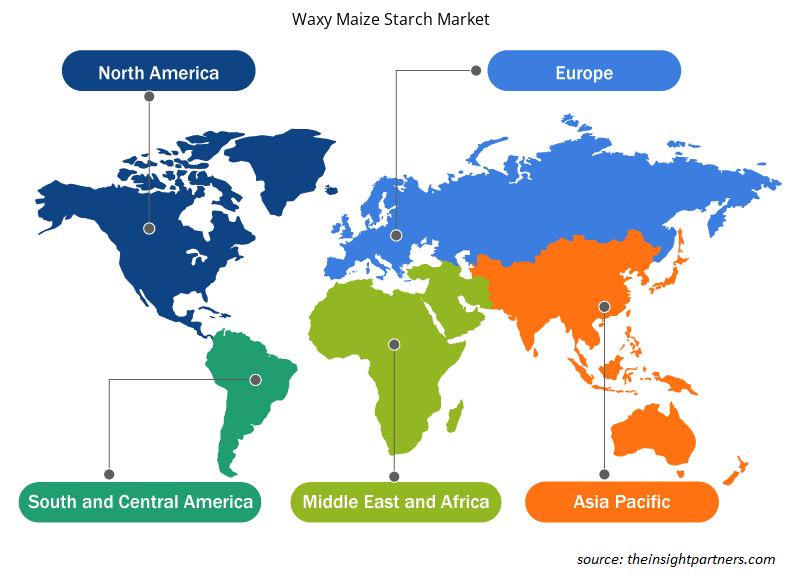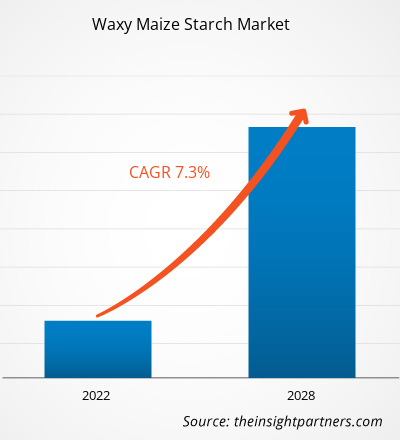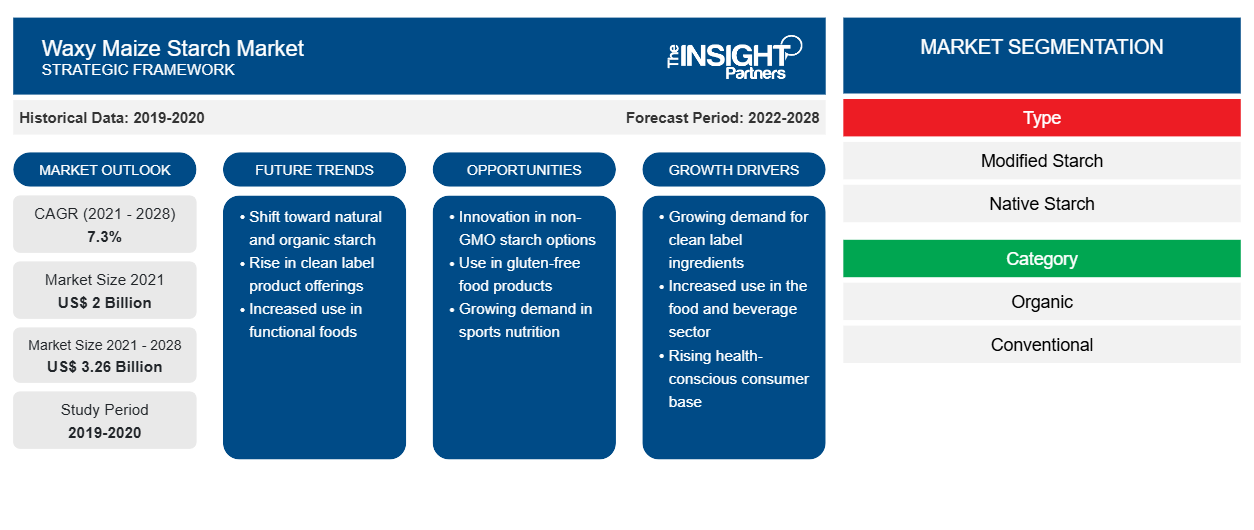Il mercato dell'amido di mais ceroso è stato valutato 2.000,68 milioni di dollari nel 2021; si prevede che crescerà a un CAGR del 7,3% dal 2022 al 2028.CAGR of 7.3% from 2022 to 2028.
L'amido di mais ceroso è un carboidrato complesso derivato dal mais o dal mais. Viene utilizzato come additivo in vari settori di utilizzo finale, come quello alimentare, tessile e farmaceutico. Viene aggiunto ai singoli filati per aumentarne la resistenza meccanica e all'attrito e anche per resistere alla penetrazione dell'umidità. Serve anche come stabilizzatore e riempitivo per inchiostri colorati quando i tessuti vengono sovrastampati. Il consumo di amido di mais ceroso è aumentato in modo significativo nell'industria alimentare, in quanto viene utilizzato come agente addensante in zuppe e sughi, ripieni di torte, stufati e casseruole e salse grazie alla sua elevata capacità di assorbimento dell'acqua. È probabile che il mercato dell'amido di mais ceroso cresca in modo significativo nel prossimo futuro grazie alle sue proprietà funzionali, come la formazione di schiuma e la gelificazione, che lo rendono un additivo essenziale per vari settori di utilizzo finale.
L'Asia Pacifica ha detenuto la quota di mercato più grande dell'amido di mais ceroso nel 2021, mentre altre regioni in via di sviluppo, come Medio Oriente e Africa, dovrebbero crescere in modo significativo nel periodo di previsione. Il mercato sta proliferando a causa della potenziale base di clienti di economie in via di sviluppo come Cina e India, delle preferenze alimentari delle persone e della crescente domanda di prodotti alimentari sani e funzionali. L'amido di mais ceroso è ampiamente utilizzato nei settori alimentare e delle bevande e della produzione tessile e della carta per stabilizzare ed emulsionare i prodotti e come legante in polvere nell'industria farmaceutica. Secondo la China Starch Industry Association, nel 2021 in Cina sono state prodotte 39,17 milioni di tonnellate di amido di mais. Si prevede che tutti questi fattori stimoleranno la crescita del mercato dell'amido di mais ceroso durante il periodo di previsione.
Personalizza questo report in base alle tue esigenze
Riceverai la personalizzazione gratuita di qualsiasi report, comprese parti di questo report, o analisi a livello nazionale, pacchetto dati Excel, oltre a usufruire di grandi offerte e sconti per start-up e università
-
Scopri le principali tendenze di mercato in questo rapporto.Questo campione GRATUITO includerà analisi di dati che spaziano dalle tendenze di mercato alle stime e alle previsioni.
Impatto della pandemia di COVID-19 sul mercato dell'amido di mais ceroso
La pandemia di COVID-19 ha portato sfide senza precedenti per molti settori all'inizio del 2020. Lockdown, restrizioni alle frontiere, divieti di viaggio, interruzione della produzione e altre misure di sicurezza implementate dai governi secondo le linee guida dell'OMS e dei ministeri della salute nazionali hanno ostacolato le operazioni di produzione. Tuttavia, nel 2021, varie economie e industrie hanno ripreso le operazioni poiché diversi governi di diversi paesi hanno annunciato l'allentamento delle restrizioni imposte in precedenza. Ai produttori è stato consentito di operare a piena capacità, il che li ha aiutati a superare i divari di domanda e offerta e altre ripercussioni. Inoltre, i produttori di amido di mais ceroso si stanno concentrando sull'aumento della loro produzione per rilanciare le loro attività entro la fine del 2022.
Approfondimenti di mercato
Sviluppi strategici crescenti da parte dei principali attori del mercato
I produttori di amido di mais ceroso stanno realizzando sviluppi strategici, come innovazione di prodotto, espansione della capacità degli impianti e fusioni e acquisizioni, per rafforzare la loro posizione di mercato ed espandere la loro base di clienti. Ad esempio, a settembre 2021, AGRANA Beteiligungs-AG, uno dei principali produttori di amidi e altri ingredienti alimentari, ha investito 24,87 milioni di dollari USA nell'espansione del suo impianto di produzione di amido speciale in tutta l'Austria. L'amido speciale da lavorare nello stabilimento austriaco comprende amido di mais ceroso e amido di mais biologico. Con l'espansione della capacità dell'impianto, l'azienda prevede di soddisfare la crescente domanda di amidi speciali in Austria e in altri mercati europei. Pertanto, si prevede che i continui sviluppi strategici da parte degli operatori di mercato forniranno immense opportunità al mercato dell'amido di mais ceroso durante il periodo di previsione.
Informazioni basate sul tipo
In base al tipo, il mercato dell'amido di mais ceroso è suddiviso in amido modificato e amido nativo. Si prevede che il segmento dell'amido nativo acquisirà una quota di mercato maggiore durante il periodo di previsione. L'amido nativo è ampiamente utilizzato come agente testurizzante, gelificante, stabilizzante e addensante dai produttori di alimenti e bevande. Può essere aggiunto a un'ampia gamma di prodotti alimentari, tra cui prodotti da forno, zuppe e salse, prodotti a base di carne lavorata, snack, bevande alcoliche e analcoliche e miscele secche. Inoltre, è utilizzato come addensante universale per vernici e vari rivestimenti. Nella produzione di adesivi per etichette, l'amido ceroso nativo mostra una maggiore capacità adesiva quando si lavora su macchine ad alta velocità. Cargill Incorporated, Roquette Frères e Tate and Lyle sono i principali produttori di amido di mais ceroso.
Approfondimenti basati sulle categorie
In base alla categoria, il mercato dell'amido di mais ceroso è segmentato in biologico e convenzionale. Si prevede che il segmento biologico registrerà un CAGR più elevato nel mercato durante il periodo di previsione. È di qualità superiore rispetto al mais inorganico. Pertanto, si prevede che la domanda di amido di mais biologico aumenterà rapidamente nei prossimi anni poiché i clienti richiedono prodotti naturali e di qualità premium. Nell'industria alimentare, l'amido di mais ceroso biologico è spesso utilizzato come addensante. Ad esempio, è utilizzato come emulsionante nei condimenti per insalate, nei pasti pronti , nelle zuppe e negli alimenti per l'infanzia. Inoltre, i prodotti vegani sono realizzati con amido biologico privo di OGM.
Approfondimenti basati sulle applicazioni
In base all'applicazione, il mercato dell'amido di mais ceroso è segmentato in alimenti e bevande, integratori alimentari, prodotti farmaceutici e nutraceutici e altri. Si prevede che il segmento dei prodotti farmaceutici e nutraceutici registrerà il CAGR più elevato nel mercato durante il periodo di previsione. L'amido di mais e i suoi derivati sono utilizzati anche in formulazioni topiche, come unguenti e lozioni. È utilizzato in varie forme di dosaggio, tra cui compresse deglutibili, capsule rigide, miscele, granuli e premiscelati di pellet. La pasta di amido di mais con una concentrazione del 5-20% è frequentemente impiegata nella produzione di compresse per migliorare la capacità legante della formulazione.
I principali attori che operano nel mercato dell'amido di mais ceroso sono Cargill, Incorporated; Tate & Lyle PLC; AGRANA Beteiligungs-AG; Manildra Group; Roquette Frères; Sinofi Ingredients; Tokai Denpun Co., Ltd.; Sanwa Starch Co., Ltd.; New Zealand Starch Limited; e SAMYANG CORPORATION. Questi attori sono impegnati nello sviluppo di prodotti con rischi per la salute ridotti per soddisfare le tendenze emergenti dei consumatori e rispettare i quadri normativi. Sono coinvolti in fusioni e acquisizioni, espansioni aziendali e partnership per espandere la loro quota di mercato.
Approfondimenti regionali sul mercato dell'amido di mais ceroso
Le tendenze regionali e i fattori che influenzano il mercato dell'amido di mais ceroso durante il periodo di previsione sono stati ampiamente spiegati dagli analisti di Insight Partners. Questa sezione discute anche i segmenti e la geografia del mercato dell'amido di mais ceroso in Nord America, Europa, Asia Pacifico, Medio Oriente e Africa e America meridionale e centrale.

- Ottieni i dati specifici regionali per il mercato dell'amido di mais ceroso
Ambito del rapporto di mercato dell'amido di mais ceroso
| Attributo del report | Dettagli |
|---|---|
| Dimensioni del mercato nel 2021 | 2 miliardi di dollari USA |
| Dimensioni del mercato entro il 2028 | 3,26 miliardi di dollari USA |
| CAGR globale (2021 - 2028) | 7,3% |
| Dati storici | 2019-2020 |
| Periodo di previsione | 2022-2028 |
| Segmenti coperti |
Per tipo
|
| Regioni e Paesi coperti |
America del Nord
|
| Leader di mercato e profili aziendali chiave |
|
Densità dei player del mercato dell'amido di mais ceroso: comprendere il suo impatto sulle dinamiche aziendali
Il mercato dell'amido di mais ceroso sta crescendo rapidamente, spinto dalla crescente domanda degli utenti finali dovuta a fattori quali l'evoluzione delle preferenze dei consumatori, i progressi tecnologici e una maggiore consapevolezza dei benefici del prodotto. Con l'aumento della domanda, le aziende stanno ampliando la propria offerta, innovando per soddisfare le esigenze dei consumatori e capitalizzando sulle tendenze emergenti, il che alimenta ulteriormente la crescita del mercato.
La densità degli operatori di mercato si riferisce alla distribuzione di aziende o società che operano in un particolare mercato o settore. Indica quanti concorrenti (operatori di mercato) sono presenti in un dato spazio di mercato in relazione alle sue dimensioni o al valore di mercato totale.
Le principali aziende che operano nel mercato dell'amido di mais ceroso sono:
- Cargill, Incorporata
- Società per azioni Tate & Lyle
- AGRANA Beteiligungs-AG
- Gruppo Manildra
- Fratelli Roquette
Disclaimer : le aziende elencate sopra non sono classificate secondo un ordine particolare.

- Ottieni una panoramica dei principali attori del mercato dell'amido di mais ceroso
Segnala i riflettori
- Tendenze progressive del settore nel mercato dell'amido di mais ceroso per aiutare gli operatori a sviluppare strategie efficaci a lungo termine
- Strategie di crescita aziendale adottate per garantire la crescita nei mercati sviluppati e in via di sviluppo
- Analisi quantitativa del mercato dell'amido di mais ceroso dal 2022 al 2028
- Stima della domanda globale di amido di mais ceroso
- Analisi delle cinque forze di Porter per illustrare l'efficacia degli acquirenti e dei fornitori che operano nel settore
- Sviluppi recenti per comprendere lo scenario competitivo del mercato
- Tendenze e prospettive di mercato e fattori che regolano la crescita del mercato dell'amido di mais ceroso
- Assistenza nel processo decisionale evidenziando le strategie di mercato che sostengono l'interesse commerciale, portando alla crescita del mercato
- Dimensioni del mercato dell'amido di mais ceroso in vari nodi
- Panoramica dettagliata e segmentazione del mercato e delle dinamiche del settore dell'amido di mais ceroso
- Dimensioni della crescita in diverse regioni con promettenti opportunità di crescita
- Analisi storica (2 anni), anno base, previsione (7 anni) con CAGR
- Analisi PEST e SWOT
- Valore/volume delle dimensioni del mercato - Globale, Regionale, Nazionale
- Industria e panorama competitivo
- Set di dati Excel
Report recenti
Testimonianze
Motivo dell'acquisto
- Processo decisionale informato
- Comprensione delle dinamiche di mercato
- Analisi competitiva
- Analisi dei clienti
- Previsioni di mercato
- Mitigazione del rischio
- Pianificazione strategica
- Giustificazione degli investimenti
- Identificazione dei mercati emergenti
- Miglioramento delle strategie di marketing
- Aumento dell'efficienza operativa
- Allineamento alle tendenze normative























 Ottieni un campione gratuito per - Mercato dell'amido di mais ceroso
Ottieni un campione gratuito per - Mercato dell'amido di mais ceroso